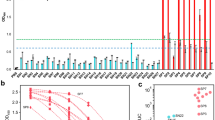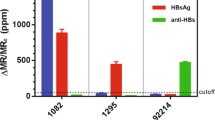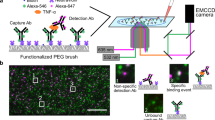Abstract
Conventional fluoroimmunoassay (FIA) methods based on various fluorescence principles have not achieved the sensitivity of radioimmunoassay (RIA) mainly because of problems of background fluorescence arising, for example, from the biological specimen. We now describe an immunoassay of hepatitis B surface antigen (HBsAg) based on time-resolved (TR) fluorescence1 using a lanthanide as label. The assay initiates the development of a new generation of immunoassays. The fluorescence intensity is measured after a selected delay time which almost completely eliminates background fluorescence, which has a fast decay time. The excitation is performed with a flashing light source. The molecules with a long fluorescent lifetime consist of chelates of rare earth metals (Eu, Tb, Sm, Dy). They absorb strongly the excitation radiation and transfer the energy to the chelated central atom which in turn produces an emission spectrum characteristic of the lanthanide used. A long Stokes' shift (>270 nm) helps to reduce the background in the emission region of the chelate and thus optimizes measurement of the relevant fluorescence. The present TR-FIA uses 2-naphthoyltrifluoroacetone as chelating agent because it creates an intense fluorescence with the rare earth metals. Synergistic agents such as trioctylphosphineoxid further enhance the fluorescence of the chelate. Depending on the instrumentation used for measuring time-resolved fluorescence and the conditions used for chelate formation, lanthanides can be detected at 10−12–10−14 M concentrations1,2.
This is a preview of subscription content, access via your institution
Access options
Subscribe to this journal
Receive 51 print issues and online access
$199.00 per year
only $3.90 per issue
Buy this article
- Purchase on Springer Link
- Instant access to full article PDF
Prices may be subject to local taxes which are calculated during checkout
Similar content being viewed by others
References
Soini, E. & Hemmilä, I. Clin. Chem. 25, 353–361 (1979).
Yamada, S., Miyoshi, F., Kano, K. & Ogawa, T., Analyt. chim. Acta 127, 195–198 (1981).
Tiollais, P., Charnay, P. & Vyas, G. N., Science 213, 406–411 (1981).
Wright, R. Clin. Gastroenterol. 9, 97–115 (1980).
Burrell, C. J. Clin. Gastroenterol. 9, 47–63 (1980).
Koistinen, V. U., J. Virol. 35, 20–23 (1980).
Author information
Authors and Affiliations
Rights and permissions
About this article
Cite this article
Siitari, H., Hemmilä, I., Soini, E. et al. Detection of hepatitis B surface antigen using time-resolved fluoroimmunoassay. Nature 301, 258–260 (1983). https://doi.org/10.1038/301258a0
Received:
Accepted:
Issue Date:
DOI: https://doi.org/10.1038/301258a0
This article is cited by
-
Mn2+-activated calcium fluoride nanoprobes for time-resolved photoluminescence biosensing
Science China Materials (2019)
-
Perspectives and challenges of photon-upconversion nanoparticles - Part II: bioanalytical applications
Analytical and Bioanalytical Chemistry (2017)
-
Biocompatible and label-free amperometric immunosensor for hepatitis B surface antigen using a sensing film composed of poly(allylamine)-branched ferrocene and gold nanoparticles
Microchimica Acta (2011)
-
Lanthanide-based time-resolved luminescence immunoassays
Analytical and Bioanalytical Chemistry (2011)
Comments
By submitting a comment you agree to abide by our Terms and Community Guidelines. If you find something abusive or that does not comply with our terms or guidelines please flag it as inappropriate.



